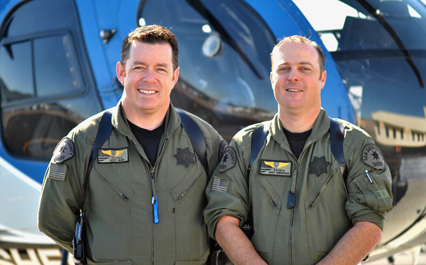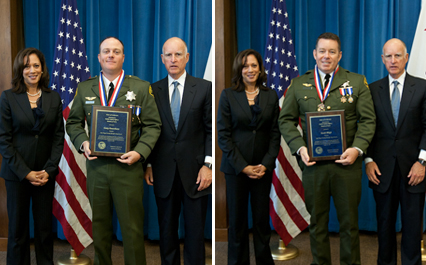What worked for you? What didn't? Here's what your fellow County employees are saying. Thanks to those who wrote and sorry we had to edit some of your responses down - too much good stuff!
I didn’t plan on it, but I just happened to have a large flashlight and a battery-powered radio at home. But I realized I didn’t have any non-perishable food. The whole experience showed me that I need to be better prepared for an emergency.
-Joann Ghianni, HHSA
I almost exclusively communicated via text during the blackout and when I needed to convey messages to a large group I found that sending one message to multiple people was much more efficient than making numerous calls to various individuals.
-Thomas Johnson, HHSA
A battery operated radio is the most important thing, flash lights and candles too. Candles are so inexpensive you can keep them on hand.
Target stores remained open and accepted cash and all credit cards. During the blackout they operated on a back-up power source.
A family emergency plan should be in place for all families.
-Darrin Knox, Probation
What worked:
- Was glad I had bought a 10-hour backup battery for my cell phone.
- Had some great new LED flashlights.
- Brought my solar garden lights indoors.
- My portable battery-operated radio was great.
- Happy to have bought some big multi packs of batteries at Costco which I store in my refrigerator so they last longer.
- Was lucky I filled up my gas tank the night before. But that was just luck—I’ll make sure I keep it no less than half-full from now on.
- Had plenty of staples like peanut butter and canned goods on hand. Had enough bottled water/soda to last for a few days.
What I’d change:
- I’ll be sure to keep more cash on hand.
- I’d buy a bigger water storage container—like a two or three gallon one.
- A portable battery-operated TV would have been nice!
-Tony Potter, Sheriff's Dept.
Have a fully stocked emergency kit on and that has (among other things) flashlights – one for each member of the family, as well as battery powered lanterns and a radio, and plenty of extra batteries and light bulbs.
Have extra ice on hand if you have the freezer space (minimum of one 10-pound bag if possible), and it is a good idea to put a bag of ice in a cooler as well for use in cooling beverages without opening the freezer door repeatedly.
-Steven Kelly Gaffrey, Dept. of Planning and Land Use
I was pretty much prepared:
Flashlight for every room;
3 Gallon Gas Can (filled)
Water for 3 persons for 3 days (3-24pks bottled water)
Batteries
Battery operated candles
Canned food
Charcoal & Grill
Transistor Radio
Camping dishes, plastic utilities
Baby wipes (to freshen up)
Small Utility (Battery Charger, Air compressor, electric /USB plugs, large work light)
CELL PHONE/CHARGED LAPTOP/w/data card --SOCIAL NETWORK
PLACE to meet family members if communication breaks down; PLAN B if traffic/transportation not available.
MISSING: ICE –CASH ON HAND!!
-Debra Mantack, HHSA
What Worked
UPS Battery. I had an uninterruptible power supply (UPS) backup battery handy, typically used to shut down a computer properly in the event of an outage.
Matches/Propane Grill
Cell Phone + Social Media. Figured out immediately that the event was countywide when friends all over were reporting the outage. People should know how to turn off certain features of their smart phones to prolong the life of the battery.
What Didn’t Work
Had an old battery-powered walkman, but no external speakers for all of the family to hear. Ended up using my cell phone’s speaker to play back the IHeartRadio app streaming KOGO600 over a spotty 3G connection.
I could have used a cigarette lighter (D/C to A/C) inverter if I needed to plug-in devices and run it off the car.
-Arnold De Guzman, Communications Office
Keeping a generator for cooling the home having elderly parents
Water bottle
Extra flashlights and batteries
Making sure keeping a care changers for my cellular phone
Enough Gas in the car
Keep some cash on hands as the credit machines were not working at no stores
Keep some non-perishable food
And the battery operated radio to get the news.
-Nasar Tahmass, HHSA
I learned the importance of having a car charger for my cell phone and having a working radio!
-Norma Swales, Health and Human Services Agency
One thing that did not work for me is not having a battery operated radio. I felt isolated from the rest of the world.
-Lane Hicks, Auditor and Controller
What worked: Having small camping lantern or multi-purpose torches (flashlight/lantern/blinking beacon) instead of candles since fire is a concern with a toddler around. This would be especially true if there had been an earthquake since I have gas appliances. Each family member had their own lantern (which the kids loved), they were bright enough to read stories by, and are stored in the same drawer as the batteries.
Lessons learned: 1) eat what’s in the fridge (if within a few hours of the power outage) since I threw it out the next day anyway, 2) have more shelf-stable milk on hand (just have to rotate it out since it only lasts a couple of months).
-Nina D. Constantino, Health & Human Services Agency
Because local cell phone service was not possible, I called (my pre-designated) out-of-state relative who was able to call my older daughter and pass along a message to pick up my younger daughter and go home.
-René Van Vreeswyk, Department of Environmental Health
We used glow sticks that we had previously purchased from the dollar store. They come with a string so we hung them from our neck. It lit the area around you well enough that you could easily see to navigate through the house, and of course the kids loved them.
-Jerry Terry, San Diego County Library
My husband and I have a generator and that worked great (make sure you have gasoline around to power it)! Also I had bought my husband a radio that is powered by a crank (special arm on the side) and that worked perfectly!
-Rebecca J. Williamson, San Diego Superior Court
I keep a flashlight and an emergency supply kit in the trunk of my car.
-Beverly S. Randolph, Office of Emergency Services
What I needed
My son has obstructive sleep apnea and sleeps each night with a sleep apnea machine. I have delayed purchasing a power backup system for emergencies, opting instead to use an overnight stay at a hotel for such rare occasions. However, a simple boat battery, inverter and multi-purpose power source, sometimes used for camping, is an inexpensive back-up system. This configuration lasts at least 8-12 hours. It will be a purchase I make next payday.
-June Kopplin, Registrar of Voters
I am keeping my home land line and my “non-cordless” phone: when, during the blackout, my cell phone was not operational, the land line worked perfectly.
-Elisabetta Pastorelli, Office of County Counsel
We decided to put as much food from our refrigerator into our freezer and it was cold enough to save what we did have, especially a new gallon of milk and eggs. The Items were still cool enough at 1:00 a.m. when the power came back on.
-Jocelyn Wingate, Public Defender
I have two small solar lamps outside of my home. They only cost a couple of dollars at Walmart. But I took them out of the ground and used them inside during the blackout.
-Rosa Ybarra, HHSA
In my home we had plenty of flashlights and batteries. We also had a few candles. Two things I wished I had, a radio and a small grill. We had bread, peanut butter, jelly and some crackers. But I had no way to heat up water. That won’t be happening next time though.
-Adela Valdez, Probation
My husband and I keep some battery operated motion sensor lights in our closet, the bathroom and on the front/back porch areas. While we spent most of the time outside, we brought these sensor lights into the living area and guest bathroom so that anytime we walked into the house we had light. The fact that they are not on all the time helps to save the batteries.
-Robin Siota Breeding, Forensic Conditional Release Program
if your emergency supplies are in your garage, make sure to have the key to disengage the garage door from the electronic garage door opener. Otherwise, you won’t be able to open the garage door during a power outage.
-Mark Saalwaechter, Agency Budget Office
That I was right to have flashlights in every room. My husband doesn’t make fun of me anymore. Ha!
-Kathy Zeller, HHSA
I’m so glad that I purchased a phone that did not need electricity to work. I found this great phone set at Costco where the main phone could work without being plugged to the power.
-Norma Gabriela Pugh, Registrar of Voters







